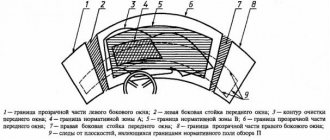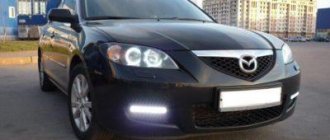What is xenon, why is it installed?
Xenon is the common name for gas-discharge lamps in which an electric arc glows in a bulb filled with gas - xenon.
This source produces bright white light, close to daylight. Xenon lamps do not have a filament like halogen lamps. An electric arc occurs between two electrodes. To ignite the arc, it is necessary to generate high-voltage (up to 25,000 V) voltage pulses. Therefore, to “ignite” such a lamp, a special control unit is used, which increases the voltage when the headlights with xenon lamps are turned on. After the lamp is lit, a nominal voltage of up to 80 V is sufficient to maintain the discharge.
Xenon and bi-xenon: all the pros and cons
Hello, our dear friends! Nice to see you again and again. And yes, today we are discussing a rather interesting topic that is relevant for many car owners - xenon or xenon lamp. Buying them is not a problem at all. Such light bulbs are sold everywhere, including regular stores and stores on the World Wide Web. But the question is, is it worth it and is it possible to change your headlights from the usual halogens to more modern bulbs, popularly called xenon?
Is it possible or not?
Actually, when I first heard about xenon, I immediately wanted to install such optics on my car. All car owners at that time who owned Mazda, Opel, Kia, Toyota, Audi and even VAZ 2114, as well as other representatives of the domestic automobile industry, lined up at the service station.
Although the xenon kit was not that cheap, and the installation could cover the cost of the kit, this stopped few people. Not surprising, because such optics have a better luminescence spectrum, they work more efficiently and last much longer.
However, before installing new headlights, I watched more than one movie, video, and re-read all possible articles. I was interested in one main question: is such a replacement legal and whether I will be fined for such a change to the car. Why? Yes, because you can expect anything from our laws.
Connecting xenon to a standard unit, to fog lights, that is, to PTF, and also as the main tool for illuminating the road surface has certain pitfalls. Many are sure that xenon beams shine very brightly, blind oncoming drivers and are generally dangerous for traffic reasons.
There is only a grain of truth in this. Any girl of the 21st century, as well as men, will say that such equipment should only be connected by professionals. This is quite logical, since it is extremely difficult to install such lamps with your own hands. The installation is considered not so impossible, but here the problem is different. There will be no problems with how to install or how to install them in standard places where halogens were previously. However, the presence of xenon in halogen reflectors does not allow the lights to shine correctly, directly on the road.
Installation is carried out together with a special additional device called an ignition unit. By putting everything in place without complying with the standards, you risk getting not only a fine from the traffic police, but also “nuts” from other road users, since you will certainly blind them.
In 2021, the new law does not prohibit the installation of xenon if it is certified and approved for use in certain types of headlights. But installation in the “collective farm” style on a car that does not meet the requirements will entail problems with the law. So before equipping your Kia, Nissan, Honda, Ford Focus or the same Skoda Octavia with new lights, ask the professionals whether such tuning is allowed specifically in your case.
I will draw a conclusion based on the information obtained. Get ready because this is important. You cannot install xenon in halogen lights. The law says so. If you violate it, you are unlikely to get away with a fine. Provision is made for deprivation of rights for 6-12 months and a ban on further operation until the characteristics of the machine comply with the standards are restored. Roughly speaking, you won’t be able to get behind the wheel until you return the halogen lights to their place.
That's it, dear friends. Everything is extremely simple and clear. If the car manufacturer provides for the installation of xenon in the foglights, install them there with ease and peace of mind. Any foreign car that provides for the initial presence of xenon does not contradict the laws of the Russian Federation. Pay attention to the markings. In most cases, we are talking about headlights marked D.
But even here there are exceptions. You can replace the low and high beams and install xenon-based PTFs even in a regular VAZ. What is the difference? Yes, the fact is that there is a certain scheme according to which bi-xenon becomes official, and therefore there can be no complaints against it from the traffic police. You will have to collect special permits, install certified equipment, spend a lot of money, but get what you want.
In any city, including such “giants” as St. Petersburg, Moscow and even Volgograd, new optics will be supplied to you without any problems. Or you can get by with a cheap alternative with deception. But we'll talk about it later.
Temperature glow
This is an important characteristic that your lens can exhibit after appropriate modifications. It is this criterion that is primarily relied upon when choosing a kit.
- From 3200 to 3500K. It glows yellow, very similar to the glow from ordinary halogen lamps. In this case, the intensity is noticeably greater. It will be suitable for fog lights, but it is not recommended to try to replace the low beam and especially the high beam with them. Not enough power.
- From 4000 to 5000k. Many people choose around 4300k because it is neutral tones with little visual distortion. Most cars come from the factory with headlights of exactly this temperature glow. They have an excellent luminous flux exceeding 3000 Lm. So if you want to change the main light, then my advice to you is to choose only this spectrum.
- From 5000 to 6000 units. This is white light and looks quite impressive. But there is a slight loss of flow power. Plus, the color gamut of objects illuminated by the machine is reduced. In many countries, xenon with more than 5000k is officially prohibited, therefore, choosing them, you will be on the verge of what is permitted.
- From 6000 to 7000k. It shines with a bright blue light, which looks very cool from the outside. I honestly admit, due to my youth and the presence of wind in my head, at first I wanted to stage something similar for myself. But they brought me to my senses in time, for which special thanks to those people. This glow has an insignificant luminous flux, as well as serious color distortions. When lighting objects, they will all appear black and white.
Where are the advantages and where are the disadvantages?
You have every right to change the light to xenon if you follow the letter of the law. On some machines this is easier to do, but on others you will have to get confused. It is difficult to say which option will fall to your lot.
If you want your car in reality to look the same as the fashionable cars in the photo with xenon optics, think carefully before going to any shop, that is, a store, buying equipment and installing it on the car.
I carefully studied the pros and cons of xenon, based on which I can draw fairly objective conclusions. Whether you agree with them or not is very interesting. So, dear readers, do not forget to leave comments.
Regarding the positive qualities, I would note the following.
- There is no filament in the design of the lighting fixture. Instead, a discharge electrode is used. Due to this solution, the service life of the headlights exceeds 3 thousand hours. This is about 10 times longer than an outdated halogen.
- Low power with simultaneously powerful light output. Imagine, a 35W lamp produces an impressive 3000Lm. Everything is learned by comparison, I know. That's why I give an example. A halogen lamp at 55 W of power will produce half as much Lm. Simple math.
- Less heating. This will prevent your headlights from cracking and your glass from breaking due to sudden temperature changes.
- Visibility. Actually, this is why I wanted to change my optics. After all, with xenon, the visibility of the roadway increases significantly. So, for reasons of safety and the ability to react in time to a traffic situation, xenon literally knocks out halogen optics.
Which headlights can xenon be installed in?
On February 20, 2010, the Road Safety Department of the Ministry of Internal Affairs of Russia gave an explanation “On the use of xenon headlights” (full text of the letter here).
Currently, the following officially approved types of headlights are installed on vehicles:
- C - low beam, R - high beam, CR - dual-mode (low and high beam) light with incandescent lamps (UNECE Rules No. 112, GOST R 41.112-2005);
— HC — low beam, HR — high beam, HCR — dual-mode light with halogen incandescent lamps (UNECE Rules N 112, GOST R 41.112-2005);
— DC — low beam, DR — high beam, DCR — dual-mode light with gas-discharge light sources (UNECE Rules N 98, GOST R 41.98-99).
An appropriate marking indicating the type of headlamp (exterior light fixture) and the approval mark (consisting of a circle containing the letter “E” followed by the number of the country which has granted approval and the approval number) is affixed to the lens of the headlamp and on the headlamp housing, if the lens can be separated from it.
The category designation for halogen incandescent lamps, shown on their base or bulb, begins with the letter “H”.
Gas-discharge light sources, the category marking of which, indicated on the base, begins with the letter “D”, in accordance with the requirements of UNECE Regulation No. 99 and GOST R 41.99-99 “Uniform provisions concerning the official approval of gas-discharge light sources for use in officially approved gas-discharge optical elements of motor vehicles" are intended for use only in headlights of DC, DR, DCR types.
Therefore, xenon lamps can only be installed in headlights marked DR, DC, DCR. If you have installed gas-discharge lamps in a headlight marked HR, NS, HCR, then you will not be able to persuade a traffic police officer to give a verbal warning if he notices a violation.
How to Avoid or Minimize Legal Liability
Car production does not stand still, and manufacturers regularly update models. If the old model had conventional halogen headlights, and the new one has xenon headlights, then you can safely purchase official spare parts and install them on your car. In this case, there will be no violation of the law and the driver cannot be held accountable.
However, even if unsuitable lamps are installed on the car, everything is ambiguous. This is due to the incomplete development of the norms of the Code of Administrative Offenses of the Russian Federation. Article 12.5 of the Code of Administrative Offenses has a reference to the “Basic Provisions”, which set out all the requirements for lighting devices.
Upon closer examination, it is clear that the document establishes a whole list of characteristics:
- type and number of lighting fixtures;
- location and operating hours;
- emitted color;
- compliance with a specific vehicle.
However, even an incorrectly installed xenon will not violate all of the above requirements. The most important condition will be the emission of white light and then the headlights can be considered adequate. The condition of matching the headlight and a specific vehicle does not work in reality, since only a small number of devices indicate specific car models.
IMPORTANT !!! If you can prove this fact, then the violation falls under part one of this article, the punishment for which is only a fine of 500 rubles.
Unfortunately, in practice there is very little chance of proving this entire chain. Most inspectors refer to the discrepancy between headlights and lamps and draw up a report that goes to court. At this stage, it is unlikely that you will be able to prove your case on your own, so you should seek help from a qualified lawyer. According to statistics, courts most often take the position of a civil servant, and therefore the chances of success are minimal. In addition, from 2021 a new law on indexation for northerners will come into force.
Why was the installation of xenon banned?
The above document provides explanations from the Federal State Unitary Enterprise “Research and Experimental Institute of Automotive Electronics and Electrical Equipment”, according to which the use of light sources in external lighting devices that do not correspond to the type of the given lighting device violates the conditions for ensuring road safety due to a number of physical factors (dimensions of the spark discharge, wavelength, scattering angle of reflected radiation) and technical (class of reflective surface of the reflector, presence on the vehicle of an automatic light beam corrector and headlight washer) factors.
Thus, the use of gas-discharge light sources in headlights intended for use with incandescent lamps, including halogen lamps, is not permissible.
Punishment for non-standard xenon until 2021
There is no direct ban in the administrative code on xenon lamps in conventional headlights. Until 2021, for driving a vehicle with such headlights, traffic police officers qualified under Part 3 of Article 12.5 of the Code of Administrative Offenses of the Russian Federation :
Driving a vehicle on the front of which are installed lighting devices with red lights or red reflective devices, as well as lighting devices, the color of the lights and the mode of operation of which do not comply with the requirements of the Basic Regulations for the admission of vehicles to operation and the duties of safety officials traffic, -
entails deprivation of the right to drive vehicles for a period of 6 months. up to 1 year with confiscation of the specified instruments and devices.
What requirements of the main provisions are discussed in the law?
The appendix to the Traffic Rules contains a list of malfunctions and conditions when operating the vehicle is prohibited. These include cases where the number, type, color, location and operating mode of external lighting devices do not meet the requirements of the vehicle design. And also: when the headlights use lenses and lamps that do not correspond to the type of the given lighting device.
Thus, traffic police officers, in order to bring the driver to administrative responsibility, removed the ignition unit with a xenon lamp installed in the headlight and recorded markings on the headlight, which indicate that only a halogen lamp can be installed in it.
Similar cases were considered by magistrates' courts. Most of the reviews ended in deprivation of the right to drive.
Is it possible to install xenon in PTF?
In order not to lose your rights and avoid fines, strictly follow the letter of the law. Remember that the answer to the question whether xenon can be installed in fog lights will be positive only in one case - if the headlights are adapted to it. Before installing gas-discharge bulbs in PTFs, pay attention to their markings. It will tell you whether xenon is allowed or not in this particular case. There are three standard options:
— DC – xenon bulbs can be used for low beam;
— DR – xenon bulbs can be used for high beams;
— DCR – xenon bulbs can be used in both modes.
In all other cases, installing gas-discharge lamps is prohibited by law. Be careful to avoid violations and avoid troubles on the road.
Speaking about whether it is possible to drive with xenon lamps in PTF, we should mention the so-called “exception to the rule”. There are situations when, at the time of purchasing a car, it is not equipped with xenon headlights, but in a new configuration that appeared on the market later, they are already present. What should the driver do in this case? According to experts, the best way out of the situation would be to buy new fog lights, adapted for xenon light sources, and install them in place of the old ones. This way you can comply with the law and ensure maximum comfort on the road.
Fine for xenon in 2021
In 2021, the Plenum of the Supreme Court of the Russian Federation issued a resolution (dated June 25, 2019 No. 20), which clarified the issues of applying administrative legislation in the event of detection of illegally installed xenon in car headlights. Namely:
The objective side of the offense provided for in Part 3 of Article 12.5 of the Code of Administrative Offenses of the Russian Federation can only occur in the event of a simultaneous discrepancy between the color of the lights and the operating mode of such devices with the requirements specified by the vehicle manufacturer in the operational documentation.
If only the color or operating mode of the light devices installed on the vehicle does not comply with the above requirements, driving such a vehicle may be qualified under Part 1 of Article 12.5 of the Code of Administrative Offenses of the Russian Federation.
Thus, the wording of the law has not changed as a result. Its interpretation has changed. Currently, installing xenon in headlights not designed for this type of lamp is considered a modification to the design of the vehicle.
If a traffic police officer detects such a violation, he will issue a fine under Part 1 of Article 12.5 of the Code of Administrative Offenses of the Russian Federation, for which a fine of 500 rubles is provided. However, that's not all. Along with the fine, the inspector will demand that the violation be eliminated and set a period of 10 days for this. If the violation is not eliminated, the registration of the vehicle will be terminated.
Ask a Question
Here you can refer to the topic of the article or request assistance in appealing the fine
Don't miss new useful publications
We will tell you about the intricacies of the legislation, help you understand it and tell you what to do in controversial situations.
Responsibility for violating the rules for operating lighting devices
Art. 12.5 of the Code of Administrative Offenses establishes the provision according to which the use of non-standard lighting devices is prohibited. The sanction does not provide for a fine, and if a violation is detected, the driver will be limited in the right to drive a vehicle from six months to 1 year with the confiscation of illegal devices and related devices.
The conditions for liability are:
- use of headlights emitting red light or light-returning devices of a similar color;
- operation of lighting devices whose characteristics do not comply with the rules for admission to the use of a vehicle.
- These admission rules are established in the 2 above-mentioned legal acts. If they are violated, the use of the vehicle is also prohibited:
- The mode and type of operation of the headlights is not suitable as intended by the manufacturer and cannot be installed on a specific car model (it is important that headlights from other cars can be installed on models that are no longer in production):
- headlight adjustment does not comply with the standards established by GOST;
- diffusers or lamps are not suitable for the type of lighting device.
The law does not establish any other requirements. However, from the provisions of this article it is already clear that the use of “illegal” xenon is punishable by deprivation of rights for up to 1 year.









